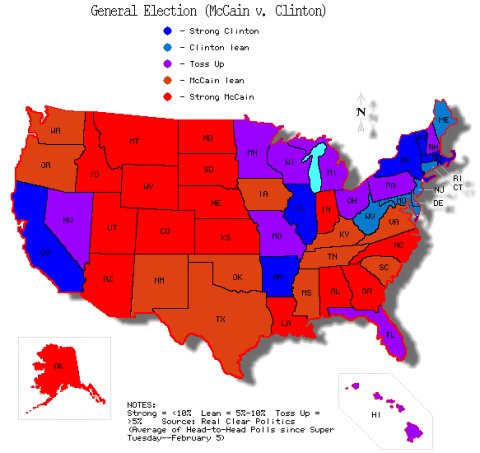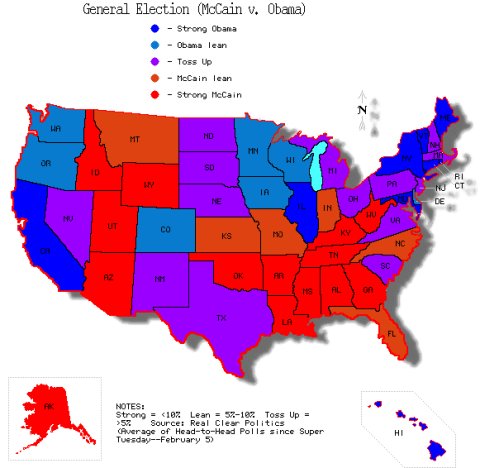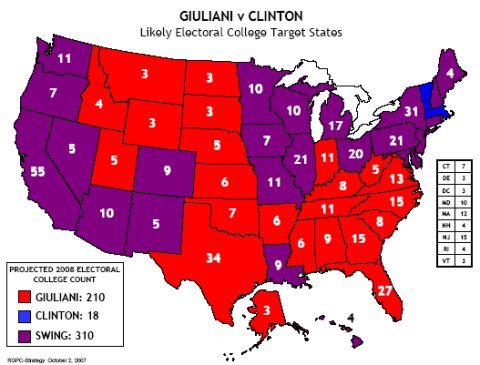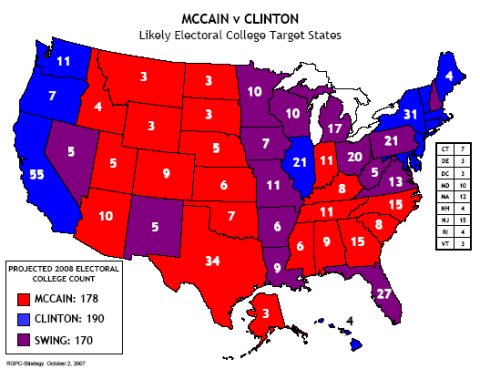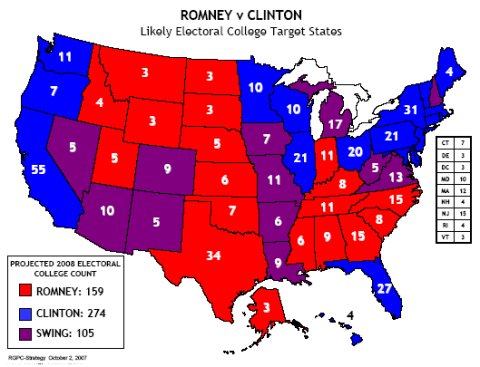One of the most fascinating use of maps I’ve seen this election cycle was when Rudy Giuliani‘s camp constructed hypothetical Electoral College outcomes to push the narrative that he was the most electable candidate. They released four maps, with each one pairing one of the GOP candidates against Hillary Clinton, who in October 2007, when the maps were released, was considered the odds-on favorite for the Democratic nomination.
Of course Giuliani’s maps implied that he would start with the most Electoral College votes. The maps had him beginning with 210 votes to Clinton’s 18, with 310 up for grabs. Meanwhile, the maps suggested John McCain would begin with 178 to Clinton’s 190 and Mitt Romney would start with 159 to Clinton’s election-sealing 274. The McCain camp responded in kind, releasing its own map showing where the Arizona senator was stronger (and weaker for that matter) than Rudy against Hillary. (Maps 3 – 6)
With the once-jumbled Republican race decided, it’s now the Democrats’ turn to argue about electability. The Obama camp has been touting red state victories as examples that he would expand the electoral map. Meanwhile, Hillary surrogate Evan Bayh suggested March 23 that Clinton’s success in larger states means she’d be a stronger general election candidate and Hillary herself reiterated that sentiment this week, arguing that she would face McCain with more big state “anchors” in place.
With Obama and Clinton’s arguments in mind, University of Georgia doctoral candidate Josh Putnam decided to parse the polls and map out likely scenarios. Armed with the latest data from Real Clear Politics, Putnam drew up two Electoral College maps showing how each candidate fares against McCain in all 50 states. What did he find? “The results don’t really support Bayh (or Clinton).” According to Putnam:
“In the McCain-Clinton contest, the solid and leaning categories give McCain a 235-179 electoral college vote advantage with 124 electoral votes falling in “toss up” territory. If you allocate those states’ votes to the candidate with the leading average, McCain wins by a 90 electoral college vote margin, 314-224. To a large degree, the map looks similar to the map from 2004. The GOP gains Oregon, Washington, Michigan and Wisconsin while the Democrats take Ohio and Arkansas. These polls indicate that McCain would maintain Florida and Clinton would hold on to Pennsylvania. But even with Pennsylvania and Ohio in the Democratic column, Clinton loses the election.”
General Election: Clinton v. McCain (Josh Putnam)
I think it’s interesting that Clinton is running strong in the old Democratic states of Arkansas and West Virginia. She obviously has appeal here, but should we really think that come crunch time these states will lay-ups? It’s also fascinating that she likely has a hopeless coaltion west of the Mississippi.
When it comes to Obama vs. McCain, Putnam notes:
“The first impression is that there are far fewer solidly red or blue states and a lot more toss up states. Among those toss ups though are several typically ruby red states; both in the South and in the plains (South Carolina, Texas, North Dakota, South Dakota and Nebraska). Factoring in the toss ups, Obama has a 199-174 lead over McCain with 165 electoral votes to close to call. Again, if those electoral votes are allocated to the candidate leading in the average of post-Super Tuesday state polls, Obama claims victory by a 273-265 margin. That’s pretty close to the 2000 outcome. Of the red toss up states listed above, Obama manages a win in North Dakota.”
General Election: Obama v. McCain (Josh Putnam)
I think Obama clearly puts more states in play by drawing independents in the Mountain West and mid-Atlantic, but I think his strength in Texas and Nebraska are probably just reflections of outlying polls. If you want to talk ruby-red states that Obama could make a run on, let’s talk Montana and North Carolina.
For the record, here are the Rudy and McCain campaign maps (all released in late October, 2007):
Rudy Map of General Election: Giuliani vs. Clinton
Rudy Map of General Election: McCain vs. Clinton
Rudy Map of General Election: Romney vs. Clinton

